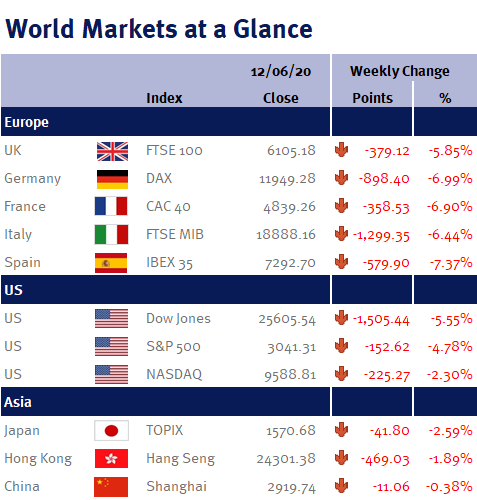Global equity markets rose strongly over the week after strong US employment data indicated, as we have been forecasting, that the coronavirus outbreak is a transient issue and as a result the global recovery will be V-shaped.
As you can see from the accompanying table, the FTSE-100 ended the week up 6.71%, which means that the FTSE-100 has now increased nearly 30% since its low on 23 March 2020. This vindicates why we said during March and April that it was important to look past the negative news headlines and resist the urge for any knee-jerk reactions and instead maintain a long-term perspective – as the American poet, Theodore Roethke said, “deep in their roots, all flowers keep the light”.
However, we should still point out that the FTSE-100 is still down 14.03% since the start of 2020 – and as a result client portfolios are still down on the year: a typical Cautious portfolio is down 3.24%; Balanced -6.45%; and Adventurous -4.97%.
Today’s monthly US non-farm payroll data for May was absolutely amazing: as more than 20m US jobs were lost in April, expectations were for a further loss of 7.5m in May. However, the employment data actually showed a gain of 2.5m jobs, reducing the unemployment rate to 13.3% and clearly signalling that the worst is thankfully over – especially as employment rose sharply in leisure and hospitality; construction; and retail.
Although we knew that there was plenty of uncertainty surrounding the expected number, we certainly didn’t expect employment to increase – and the fact that today’s employment from Canada also rose by 289,600 suggests that this US data is accurate and won’t be significantly revised in the coming weeks as the US and Canada’s data is proportionally comparable.
This all suggests that the economic reopening is having a much more positive and powerful impact than even we expected in quickly sending Americans back to work, which is obviously a positive not only for the US, but the whole world – as the US economy is the biggest economy in the world and will clearly provide a strong tailwind for the rest of the world.
Furthermore, this quick turnaround also reflects the benefits of the extraordinary global level of government and central bank stimulus – and the faster employment recovers, the less likely it is that temporary job losses become permanent job losses which leave deep and long-lasting economic scars.
The only minor caveat is the number of workers classified as employed but absent – if these were instead classified as ‘unemployed on temporary layoff’, then the unemployment rate would be approximately 3 percentage points higher than the 13.3% reported (i.e. just over 16%).
Elsewhere Europe’s central bank surprised us by significantly increasing its stimulus program by €600bn as well as extending it to June 2021 – this combination, coupled with the continued easing of lockdown restrictions added to the equity market optimism, suggests to us the global reopening and V-shaped economic recovery has yet to be fully embraced by the market. As a consequence, although we expect equity market volatility will remain elevated, we also expect equity markets to continue to recover from their coronavirus nadir.
This coming week, we will be closely watching the US Fed, which will hold a two-day monetary policy meeting – and given today’s employment data, it is now unlikely that they will consider negative interest rates. Additionally, we will be looking at the weekly US jobless claims data on Thursday 11 June 2020, for more clues on the speed of rehiring employees given the on-going progress in reopening the US economy.
Other US data to note includes CPI and the University of Michigan Consumer Sentiment.
Elsewhere, we have monthly UK GDP for April; UK industrial and manufacturing production data; Chinese import and export data; and Chinese CPI.
Investment Management Team


